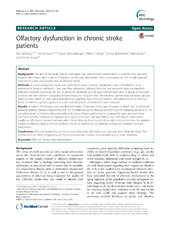| dc.contributor.author | Wehling, Eike | en_US |
| dc.contributor.author | Næss, Halvor | en_US |
| dc.contributor.author | Wollschlaeger, Daniel | en_US |
| dc.contributor.author | Hofstad, Håkon | en_US |
| dc.contributor.author | Bramerson, Annika | en_US |
| dc.contributor.author | Bende, Mats | en_US |
| dc.contributor.author | Nordin, Steven | en_US |
| dc.date.accessioned | 2016-06-29T11:53:51Z | |
| dc.date.available | 2016-06-29T11:53:51Z | |
| dc.date.issued | 2015-10-12 | |
| dc.Published | BMC Neurology. 2015 Oct 12;15(1):199 | eng |
| dc.identifier.uri | https://hdl.handle.net/1956/12220 | |
| dc.description.abstract | Background The aim of the study was to investigate odor identification performance in patients one year after hospital admittance due to stroke. Predictors for olfactory dysfunction were investigated as well as self-reported olfactory function and pleasantness of olfactory items. Methods A 1-year prospective study was performed. Stroke location, classification and comorbidities were registered at hospital admission. One year after admission, olfactory function was assessed using standardized olfactory methods (screening for loss of detection sensitivity and an odor identification test). A group of matched controls was derived from a population-based study to compare odor identification performance between groups. Patients were asked for their personal judgment regarding their olfactory function and pleasantness of odorous items. In addition, global cognitive function and symptoms of depression were assessed. Results A total of 78 patients were enrolled (46 males, 32 females; mean age 68 years) of which 28.2 % exhibited reduced olfactory function (hyposmia) and 15.4 % exhibited loss of olfactory function (10.3 % functional anosmia, 5.1 % complete anosmia). Patients showed significantly lower olfactory performance compared to age- and sex-mated matched controls. Predictors of impaired olfactory function were age and NIHSS score. Self-reports indicated no significant differences between patients with normal olfactory function and those with reduced function. Yet, patients having an olfactory dysfunction rated odorous items as significantly less pleasant compared to patients without dysfunction. Conclusions Olfactory dysfunction seems to occur frequently after stoke even one year after initial admission. The deficits seem to relate to hyposmia and functional anosmia, and less to a complete loss of smell sensitivity. | en_US |
| dc.language.iso | eng | eng |
| dc.publisher | BioMed Central | eng |
| dc.rights | Attribution CC BY 4.0 | eng |
| dc.rights.uri | http://creativecommons.org/licenses/by/4.0 | eng |
| dc.subject | Olfaction | eng |
| dc.subject | Stroke | eng |
| dc.subject | Odor identification | eng |
| dc.title | Olfactory dysfunction in chronic stroke patients | en_US |
| dc.type | Peer reviewed | |
| dc.type | Journal article | |
| dc.date.updated | 2016-02-24T12:58:32Z | |
| dc.description.version | publishedVersion | en_US |
| dc.rights.holder | Copyright Wehling et al. 2015 | |
| dc.identifier.doi | https://doi.org/10.1186/s12883-015-0463-5 | |
| dc.subject.nsi | VDP::Medisinske Fag: 700 | en_US |

